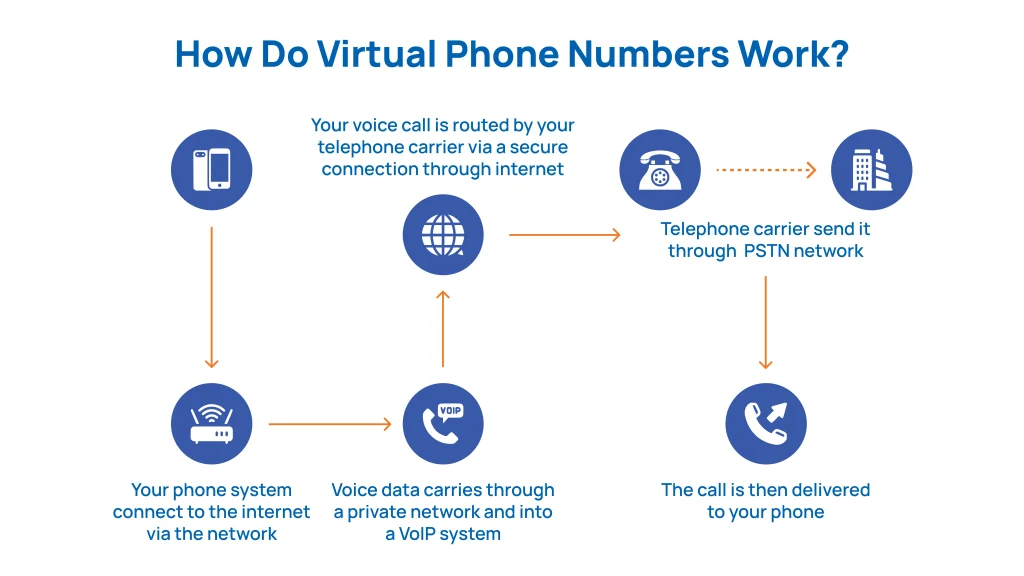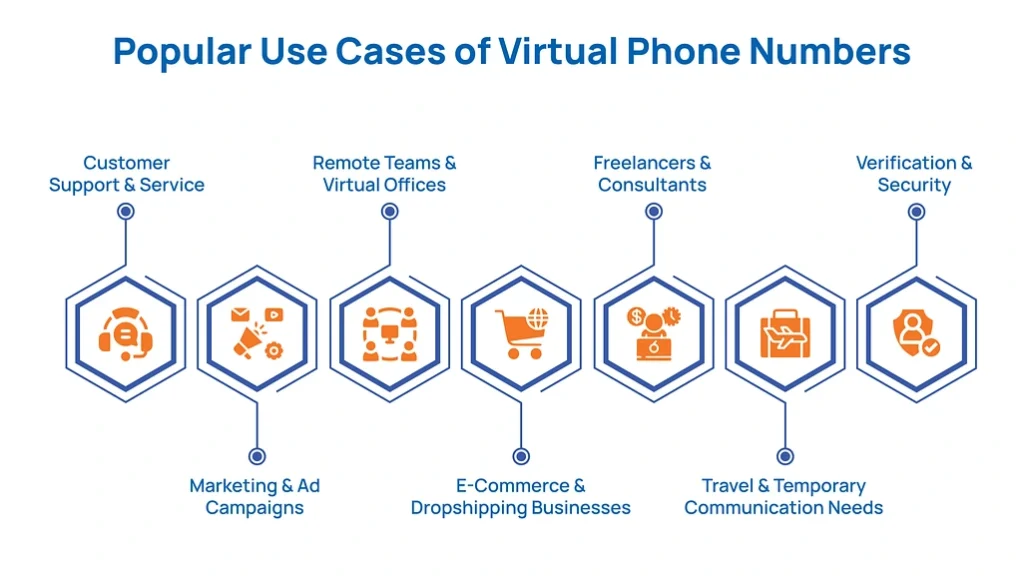There was a time when setting up a business phone system meant dealing with tangled wires, expensive hardware, and a desk phone that kept you stuck in one place. Calls could only be made or received from a fixed location, and expanding to new regions meant installing new lines, adding more costs, and creating more complications.
This shift is more relevant than ever. Businesses in the US added more than
35 million VoIP lines in the eight years between 2010 and 2018, reaching a total of 41.6 million. A significant example of this transition is the UK’s plan to shut down its analog
Public Switched Telephone Network (PSTN) by 2027, led by BT Openreach, as part of the country's digital switchover.
Regular phone lines and infrastructure will no longer function, and businesses will need internet-based systems to handle voice communication. The reason for this transition is apparent—analog networks are outdated, costly to maintain, and unable to support modern communication needs.
Virtual phone numbers allow businesses to communicate without physical limitations. There is no hardware, no fixed locations, just a number that works wherever you are, on any device, as long as you have an internet connection. In this blog, we will explore how virtual phone numbers work, their benefits, and how your business can use them to improve communication.
Quick Summary
- Virtual phone numbers eliminate physical limitations – No need for hardware or fixed locations. You can make and receive calls from anywhere using an internet-connected device.
- Different virtual phone numbers serve different needs – Local, toll-free, international, and vanity numbers help businesses establish credibility and improve accessibility.
- VoIP-powered virtual numbers offer advanced features – Call routing, IVR, voicemail transcription, and call monitoring improve efficiency and customer experience.
- Cost-effective and scalable solution – Virtual phone numbers reduce costs compared to regular landlines and grow your business without additional infrastructure.
- Enhance business presence and credibility – Local numbers make businesses appear trustworthy, while toll-free numbers encourage more customer interactions.
- Ideal for remote teams and global businesses – Employees can stay connected across different time zones without needing a physical office.
- Better privacy and security – Virtual numbers keep personal and business calls separate and offer temporary numbers for online verification.
|
What Is a Virtual Phone Number?
A virtual phone number is a phone number that isn’t tied to a physical SIM card or landline. Instead, it operates over the internet, allowing you to make and receive calls using any internet-connected device. They are also called cloud phone numbers or hosted phone numbers.
Unlike regular phone systems that rely on physical infrastructure, virtual numbers use VoIP (Voice over Internet Protocol) technology. Everyone remains reachable even if you step away from your desk or have employees working remotely. Each employee’s business line operates as a virtual phone number, ensuring seamless communication no matter where they are.
Types of Virtual Phone Numbers
- Local Phone Numbers – These numbers have a specific area code, making businesses appear local to customers in a particular city or region. For example, a bakery in New York gets a 212 area code number to attract local customers.
- Toll-Free Numbers – Customers can call these numbers without being charged, making them ideal for customer support and service-based businesses. For example, a tech company offers 1-800-HELPDESK for free customer inquiries.
- International Toll-Free Numbers – These work like toll-free numbers but can be dialed internationally at no cost to the caller, improving global customer access. For example, a U.S.-based airline provides a +44 800 number so UK customers can reach their support team for free.
- Vanity Numbers – Custom numbers that spell out a word or phrase, making them easy to remember and boosting brand recognition. For example, a grocery delivery service uses 1-800-GROCERY to make ordering simple for customers.
Difference Between a Virtual Phone Number and a Regular Phone Number
When someone calls your virtual number, they won’t notice any difference—it works like a regular phone number. However, for you, it offers more control. You can route calls to different devices, set up business-specific features like voicemail and call forwarding, and maintain multiple numbers without needing separate physical phone lines.
| Aspect |
Virtual Phone Number |
Regular Phone Number |
| Connection Type |
Uses the Internet (VoIP) |
Uses conventional phone networks (landline or cellular) |
| Device Dependency |
It can be used on multiple devices (mobile, laptop, desk phone) |
Linked to a specific device (SIM card or landline phone) |
| Location Tied |
Not tied to any particular location |
Tied to a physical location (landline) or mobile carrier |
| Call Forwarding |
Quickly forwards calls to any number or device |
Limited call forwarding options often require extra cost |
| Cost |
Generally lower costs, especially for international calls |
Higher costs, especially for international calls |
| Scalability |
Easily scalable, add new numbers as needed |
Requires new hardware or SIM for additional numbers |
| Call Management Features |
Advanced features like call recording, IVR, voicemail-to-email |
Basic features like voicemail and call waiting |
| International Calling |
Lower international calling rates can get local numbers globally |
Higher international calling costs and roaming charges apply |
| Privacy |
Keeps personal and business calls separate |
Personal and business calls are on the same number |
| Business Use |
Ideal for businesses, remote teams, and freelancers |
Primarily for personal use or businesses with physical locations |
Features of a Virtual Phone Number
Here are a few of the most valuable features and how they help your business:
1. Voicemail & Voicemail Transcription
Virtual phone numbers offer more than just basic voicemail. You can review and respond to messages through an app, ensuring no important call is missed. Some providers also offer voicemail transcription, sending written versions of messages to your email for quick reference.
2. Call Monitoring
This feature allows managers or supervisors to listen in on calls in real-time. They can provide live feedback, assist agents during customer interactions, and evaluate call performance. This is especially useful for training new employees or improving sales and support conversations.
3. Skill-Based Routing
Instead of connecting callers randomly, skill-based routing ensures that calls go to the most qualified agent. This improves customer experience by matching them with the right representative based on expertise, reducing call resolution time.
4. Interactive Voice Response (IVR)
An IVR system allows callers to navigate a menu and direct themselves to the right department. This reduces the time spent on calls and improves efficiency by filtering inquiries before they reach an agent. Businesses can use IVR to handle common customer requests, such as account balances or FAQs without needing a live representative.
How Do Virtual Phone Numbers Work?

Here is an explanation of how your business can use virtual phone numbers to streamline communication, enhance customer service, and stay connected from anywhere.
1. Call Initiation
When someone dials a virtual phone number, the call is sent to the VoIP service provider's server instead of a regular phone network.
2. Routing
The provider then routes the call based on pre-set rules. The call can be directed to a mobile phone, a landline, a VoIP-enabled device, or multiple devices simultaneously. Virtual numbers allow businesses and individuals to control how calls are handled:
- A single number can ring on different devices simultaneously or sequentially.
- Calls can be directed based on the time of day, caller ID, or recipient's availability.
- Callers can be greeted with an interactive menu to reach the right department or person.
For example, a customer service team for an online retail store uses a virtual phone number to manage incoming calls. During business hours, calls are routed to the main support desk. After hours, the system automatically forwards calls to remote agents working in different time zones or directs them to voicemail with an option for customers to request a callback. This setup ensures 24/7 customer support without requiring a physical office.
3. Connection
The call reaches the recipient over an internet connection, ensuring seamless communication. For instance, a consulting firm with international clients uses a virtual phone number to stay accessible across different regions. When a client in Europe calls, the system routes the call over the Internet to a consultant’s mobile device in the U.S. The client experiences a seamless connection, just like a regular phone call, while the consultant can take calls from anywhere without incurring international roaming charges.
Why Does Your Business Need a Virtual Phone Number?
Below are some of the benefits of using a virtual phone number for your business:
1. Cost-Effectiveness
According to a study, businesses can save up to 75% of costs by switching to a virtual business phone line. With virtual phone numbers, you don’t need to invest in expensive phone lines, hardware, or infrastructure. Since calls are made over the Internet, international calling rates are significantly lower than those of conventional phone systems.
Businesses can set up multiple numbers in different locations without the cost of maintaining physical offices or telephone systems. For instance, a small startup providing customer support globally uses virtual numbers to create a presence in different countries. Instead of setting up physical offices or expensive call centers, they route all calls through a cloud-based system, reducing costs while maintaining professional customer service.
2. Enhanced Business Presence & Credibility
Having a local number in different regions helps businesses establish trust with customers. People are more likely to answer or reach out to a number with a familiar area code. This can improve customer engagement and make your business look more established. For instance, a U.S.-based e-commerce company wants to expand into the UK and Australia. Instead of relying on a single international number, they get local virtual phone numbers for both countries. This makes contacting customers in those regions easier, increasing trust and sales.
3. Flexibility & Mobility
Since virtual numbers are not tied to a specific device, you can take calls from anywhere. You can route calls to your mobile phone, a VoIP-enabled desk phone, or a laptop. This makes virtual numbers ideal for remote teams, business travelers, and anyone who needs to stay connected on the go.
With VoIP solutions boosting productivity by up to 77%, virtual numbers make teamwork more manageable, reduce missed calls, and improve workflow. This helps businesses respond faster and work more efficiently.
4. Scalability for Growing Businesses
As your business grows, you may need additional phone numbers for different departments, teams, or locations. Virtual numbers instantly add or remove numbers without hardware upgrades or complicated installations.
For example, a SaaS company starts with a single customer support number. It assigns separate virtual numbers for sales, technical support, and billing as it grows. This makes managing incoming calls easier and directing customers to the right department, improving service efficiency.
5. Privacy & Security
A virtual phone number helps you keep personal and business communications separate. You can maintain privacy without sharing your mobile number with clients or customers. This is especially useful for professionals who interact with the public but don’t want to expose their private contact details.
Recent industry reports show that companies using virtual numbers for verification processes reduced security incidents by 82% compared to phone numbers while ensuring compliance with data protection regulations across multiple accounts and services.
6. Advanced Features & Integration
Virtual phone numbers include call recording, Interactive Voice Response (IVR), voicemail-to-email, and call analytics. You can also integrate them with CRM systems, helpdesk software, and marketing platforms to streamline communication.
For example, a telehealth provider uses virtual phone numbers with an IVR system to direct patients to the correct department—appointments, billing, or medical advice. Call recordings help ensure compliance with healthcare regulations, and CRM integration allows staff to access patient information quickly.
Popular Use Cases of Virtual Phone Numbers

Virtual phone numbers are widely used in different industries and for various purposes. Here are some of the most common use cases:
1. Customer Support & Service
Providing excellent customer support requires availability and accessibility. A virtual phone number allows businesses to offer 24/7 customer service without needing a physical office.
Customers can reach you anytime, and calls can be routed to different agents based on time zones or support levels. For example, an e-commerce company uses toll-free virtual numbers so customers can call without charges. Calls are routed to support agents in different time zones, ensuring round-the-clock assistance.
2. Marketing & Ad Campaigns
Tracking marketing efforts is essential for understanding which campaigns bring the most leads. Virtual phone numbers help by assigning unique numbers to different advertisements, allowing businesses to measure call volume and effectiveness.
For instance, a real estate agency runs multiple ad campaigns—one on social media, another in newspapers, and a third on billboards. They assign separate virtual numbers to each campaign and analyze incoming calls to determine which platform generates the most leads.
3. Remote Teams & Virtual Offices
For remote and hybrid teams, virtual phone numbers ensure seamless communication without requiring employees to be in a physical office. Team members can answer calls from anywhere, making collaboration more efficient.
For example, a tech startup with employees across different countries uses virtual numbers to keep everyone connected. Each department has its number, ensuring calls go directly to the right team members, no matter where they work.
4. E-Commerce & Dropshipping Businesses
Building customer trust is essential for online businesses, especially those without physical stores. A virtual phone number with a local area code makes your business appear more credible and accessible to customers in different regions.
For instance, a dropshipping business wants to sell in the UK but operates from the U.S. Instead of using an international number, it gets a UK-based virtual phone number, making its brand more familiar and trustworthy to local customers.
5. Freelancers & Consultants
Freelancers and consultants often work independently but must maintain a professional presence. A virtual phone number allows you to keep business and personal communication separate while maintaining a professional image.
A freelance graphic designer shares a virtual number on their website and business cards. Clients can call or message them without needing their phone number. When they are unavailable, calls go to voicemail or an assistant.
6. Travel & Temporary Communication Needs
Traveling internationally often means dealing with expensive roaming charges or SIM card changes. A virtual number eliminates these issues by allowing you to get a local number in any country, making communication easy and cost-effective.
For instance, a business traveler frequently visits Europe for meetings. Instead of buying a new SIM card in each country, they use a virtual phone number with local codes, making it easier for clients and colleagues to reach them.
7. Verification & Security (One-Time Use Numbers)
Online security is a growing concern, and sharing your number for sign-ups can lead to spam calls and privacy risks. Virtual phone numbers provide a simple solution by offering temporary or disposable numbers for verification purposes.
How to Choose the Right Virtual Phone Number Provider?
Choosing the right virtual phone number provider depends on your business needs, budget, and the features you require. Here are the key factors to consider before making a decision:
1. Pricing & Subscription Plans
Different providers offer various pricing models, including pay-as-you-go plans, monthly subscriptions, and enterprise packages. Compare pricing based on the number of users, call volume, and additional features like call recording or international calling. Look for a plan that fits your budget without unnecessary extras.
2. Features & Integrations
Not all virtual phone providers offer the same features. Consider what’s essential for your business:
- Call forwarding – Route calls to multiple devices.
- Voicemail-to-email – Get voicemails delivered as text or audio files to your email.
- IVR (Interactive Voice Response) – Automate call handling with menu options.
- Call recording – Keep records of meaningful conversations.
- CRM integration – Sync calls with tools like Salesforce or HubSpot.
Make sure the provider supports the integrations you need to streamline your workflow.
3. Customer Support Availability
Reliable support is crucial, especially if your business depends on phone communication. Check if the provider offers 24/7 support, live chat, or phone assistance. Some providers only provide email support, which may not be helpful during urgent issues.
4. International Coverage
If you need a local presence in multiple countries, ensure the provider offers international numbers. Some services provide numbers in only a few countries, while others offer global coverage. Check call rates for international calls if you frequently connect with overseas clients.
Future Trends in Virtual Telephony and VoIP
1. AI-Powered Call Handling
AI is being integrated into virtual phone systems to automate call routing, transcriptions, and customer support through voice bots. This helps businesses handle calls faster and more efficiently.
2. Integration with Business Tools
VoIP platforms increasingly integrate with CRMs, help desks, and collaboration tools. This allows teams to manage calls, customer data, and workflows from one place, improving productivity.
3. 5G and Enhanced Connectivity
With the 5G rollout, VoIP call quality and reliability are expected to improve significantly, especially for remote teams and mobile users.
4. Stronger Security and Encryption
As virtual telephony grows, so does the focus on securing communications. End-to-end encryption, multi-factor authentication, and secure cloud storage are becoming standard features.
5. More Personalized Customer Experience
Advanced analytics and voice recognition tools are helping businesses tailor interactions based on caller behavior, history, and preferences, making conversations more meaningful.
Simplify Call Management and Improve Quality With PerfectSoft.AI Solutions

Managing customer interactions across multiple channels can be challenging, especially when there’s no centralized system. Agents struggle to maintain consistency without proper tracking, leading to fragmented communication and a poor customer experience.
PerfectSoft.AI solves this by providing a unified view of customer history, seamlessly integrating interactions from email, web chat, phone calls, and more into a single interface. Whether running a high-volume BPO, customer service team, or sales operation, PerfectSoft.AI enables you to connect effortlessly across all channels while maintaining crystal-clear voice communication.
Our Solutions Include:
Omnichannel Contact Center Software: Manage voice, SMS, email, social media, and live chat from a unified platform.
Telecom Voice Services: Ensure high-quality, secure, reliable voice connections, advanced VoIP, and global reach.
Why Choose PerfectSoft.AI?
- Seamless Integration: Connect with your existing CRM and business tools.
- Cost-Effective Solutions: Optimize operations without breaking the bank.
- Scalability & Flexibility – Easily scale your contact center operations.
- 24/7 Support: Get personalized, round-the-clock assistance whenever you need it.
Your contact center deserves technology that keeps you ahead. Let’s transform your customer interactions and voice communications today.
Get Started Today!
 Here is an explanation of how your business can use virtual phone numbers to streamline communication, enhance customer service, and stay connected from anywhere.
Here is an explanation of how your business can use virtual phone numbers to streamline communication, enhance customer service, and stay connected from anywhere.
 Virtual phone numbers are widely used in different industries and for various purposes. Here are some of the most common use cases:
Virtual phone numbers are widely used in different industries and for various purposes. Here are some of the most common use cases:
 Managing customer interactions across multiple channels can be challenging, especially when there’s no centralized system. Agents struggle to maintain consistency without proper tracking, leading to fragmented communication and a poor customer experience.
PerfectSoft.AI solves this by providing a unified view of customer history, seamlessly integrating interactions from email, web chat, phone calls, and more into a single interface. Whether running a high-volume BPO, customer service team, or sales operation, PerfectSoft.AI enables you to connect effortlessly across all channels while maintaining crystal-clear voice communication.
Managing customer interactions across multiple channels can be challenging, especially when there’s no centralized system. Agents struggle to maintain consistency without proper tracking, leading to fragmented communication and a poor customer experience.
PerfectSoft.AI solves this by providing a unified view of customer history, seamlessly integrating interactions from email, web chat, phone calls, and more into a single interface. Whether running a high-volume BPO, customer service team, or sales operation, PerfectSoft.AI enables you to connect effortlessly across all channels while maintaining crystal-clear voice communication.


Comments